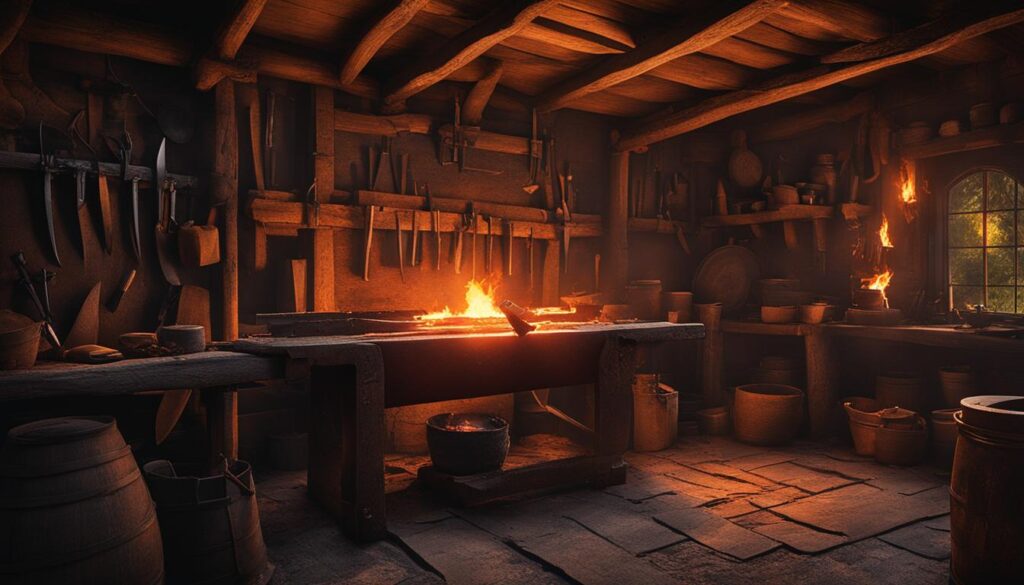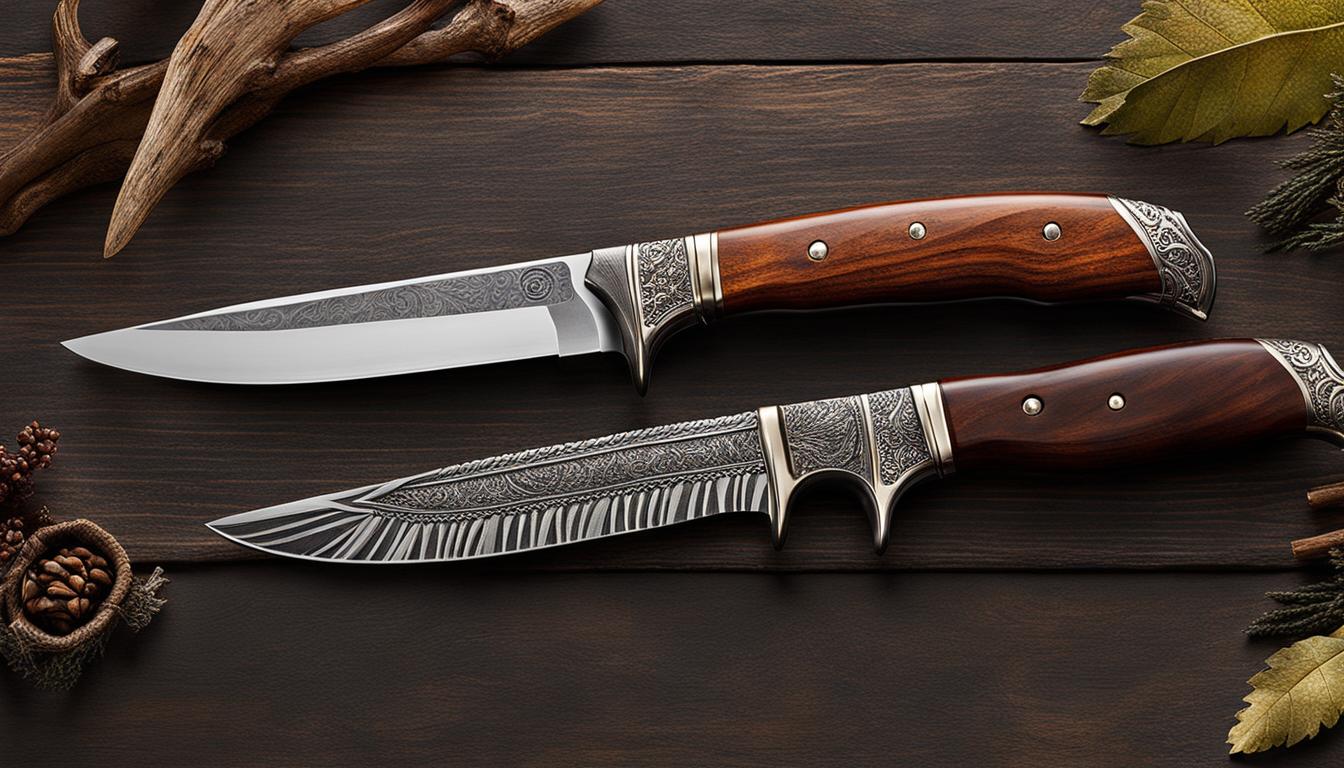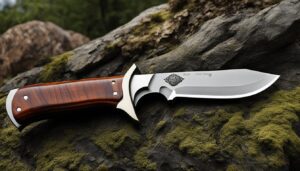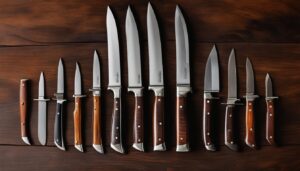Handmade hunting knives are meticulously crafted tools designed for hunting enthusiasts and outdoor adventurers. These knives offer superior sharpness, durability, and craftsmanship that cannot be replicated by mass-produced alternatives. Each knife is skillfully crafted by experienced artisans who specialize in knife making, resulting in a unique and functional tool that combines aesthetics with practicality.
Key Takeaways:
- Custom hunting knives are handcrafted tools for hunting and outdoor activities.
- They offer superior sharpness, durability, and craftsmanship compared to mass-produced alternatives.
- Experienced artisans specialize in crafting unique and functional knives.
- Custom hunting knives combine aesthetics with practicality.
- Choosing a custom hunting knife ensures a high-quality tool for your hunting needs.
The History and Evolution of Handmade Hunting Knives
In the world of hunting, the art of crafting handmade hunting knives has a long and rich history. These masterpieces of craftsmanship have evolved over time, adapting to the needs and preferences of hunters throughout the ages. Let’s explore the fascinating journey of handmade hunting knives and discover the materials, techniques, skills, and craftsmanship that have shaped these exceptional tools.
The origins of handmade hunting knives can be traced back to ancient times when early hunters used primitive tools crafted from bone and stone. As humans progressed, so did the materials and techniques used to create these knives. The discovery of iron and steel revolutionized the hunting knife industry, offering improved durability and sharpness. Today, artisans utilize high-quality steel alloys, such as stainless and Damascus steel, to create blades that are both functional and visually striking.
The craftsmanship involved in making a handmade hunting knife is truly remarkable. Skilled artisans employ a variety of techniques like forging, grinding, and heat treatment to enhance the performance and durability of the blades. Each knife is meticulously crafted, combining centuries-old traditions with modern innovation. The result is a tool that not only serves its purpose in the field but also stands as a testament to the artistry and dedication of the knife maker.
Handmade hunting knives have transcended their practical function and become objects of beauty. The intricate designs, patterns, and finishes found on these knives showcase the artistic flair and attention to detail of the craftsmen. It is this blend of functionality and aesthetics that has made handmade hunting knives highly sought after by collectors, enthusiasts, and outdoor adventurers alike.
The Evolution of Materials and Techniques
Over the centuries, materials used in the creation of handmade hunting knives have evolved, offering improved performance and durability. Early knives were fashioned from natural materials like bone, stone, and shell. However, with the advent of metalworking, iron and steel became the primary choices.
| Material | Advantages | Disadvantages |
|---|---|---|
| Iron | Durable, readily available | Prone to rust and corrosion |
| Stainless Steel | Good corrosion resistance | Less sharpness compared to carbon steel |
| Carbon Steel | Excellent sharpness and edge retention | More prone to rust and corrosion |
| Damascus Steel | Unique patterns, exceptional performance | Requires expert craftsmanship |
The introduction of advanced techniques like forging, grinding, and heat treatment further enhanced the quality of handmade hunting knives. Forging involves shaping the blade by hammering and heating the steel, resulting in a stronger and more resilient blade. Grinding refines the shape, edge, and bevels of the blade, while heat treatment optimizes its hardness and flexibility.
“A handmade hunting knife is not merely a tool; it is a work of art. The time, effort, and skill that go into creating each knife make it a true masterpiece.”
As the demand for customized knives increased, artisans began to experiment with different handle materials, such as wood, bone, and synthetic composites. These materials offer a wide range of aesthetics, durability, and grippability, allowing hunters to select a handle that suits their preferences and style.
The evolution of handmade hunting knives showcases the unwavering dedication and artistry of knife makers throughout history. From humble beginnings to the modern marvels we see today, these custom creations continue to captivate us with their beauty and functionality. The next time you hold a handmade hunting knife, take a moment to appreciate the centuries of craftsmanship that have gone into its creation.
Why Handmade Hunting Knives Are Superior
Handmade hunting knives are widely regarded as superior due to their exceptional quality, durability, customization options, and the unique connection they provide to the knife-making process.
When it comes to quality, handmade hunting knives stand above the competition. Skilled artisans meticulously craft each knife, ensuring precise attention to detail and superior craftsmanship. These knives are made to last, using the finest materials and traditional techniques, resulting in blades that are sharper, stronger, and more reliable than their mass-produced counterparts.
Customization is another key advantage of handmade hunting knives. Hunters have the opportunity to personalize their knife according to their preferences, whether it’s choosing the handle material, blade design, or adding custom engravings. This level of customization allows hunters to create a knife that not only meets their functional needs but also reflects their unique style and personality.
One of the most significant benefits of owning a handmade hunting knife is the connection it provides to the ancient art of knife-making. Each knife carries a rich history and tradition passed down through generations of skilled craftsmen. By owning a handmade hunting knife, hunters become a part of this legacy, appreciating the artistry and skill that goes into creating these functional works of art.
Table: Handmade Hunting Knives vs. Mass-Produced Knives
| Factors | Handmade Hunting Knives | Mass-Produced Knives |
|---|---|---|
| Quality | Exceptional craftsmanship; superior materials | Inconsistent quality; lower-grade materials |
| Durability | Strong and reliable; designed to withstand rigorous use | Prone to breakage; lower overall durability |
| Customization | Personalized options for handle, blade, and engravings | Limited customization options |
| Connection to the Knife-making Process | Deep appreciation for traditional craftsmanship | No direct connection to the knife-making process |
Handmade hunting knives offer superior quality, durability, customization, and a genuine connection to the ancient art of knife-making. When compared to mass-produced knives, the difference in craftsmanship and overall performance is evident. Hunters who value precision, reliability, and a personalized touch will find that a handmade hunting knife is an essential tool for their outdoor adventures.
In summary, handmade hunting knives are the epitome of superior quality and craftsmanship. These knives are expertly crafted by skilled artisans, resulting in blades that offer superior durability, sharpness, and overall functionality. The ability to customize and personalize each knife allows hunters to create a tool that reflects their unique style and preferences. By owning a handmade hunting knife, individuals become part of a long-standing tradition, connecting to the rich history and artistry of knife-making.

Choosing the Perfect Handmade Hunting Knife
When embarking on outdoor adventures, having the right equipment is essential. A reliable and high-quality handmade hunting knife is a must-have tool for any hunting enthusiast. However, with so many options available on the market, choosing the perfect knife can be a daunting task. To make the selection process easier, there are several key factors to consider.
Blade Material
The blade material plays a crucial role in determining the knife’s durability, sharpness, and overall performance. Different materials offer unique characteristics that cater to distinct hunting needs. Stainless steel is known for its corrosion resistance and ease of maintenance, making it a popular choice among hunters. Carbon steel, on the other hand, provides excellent edge retention and is easier to sharpen, but it requires more frequent maintenance to prevent rust. Blade materials like Damascus steel offer a combination of durability and aesthetic appeal, making them a desirable option for those seeking a visually striking hunting knife.
Blade Design
The design of the blade is another important consideration. Different blade shapes and features cater to specific hunting tasks. A drop-point blade offers versatility and is suitable for a wide range of applications, from field dressing to skinning. A clip-point blade provides increased precision and control, making it ideal for intricate tasks. For hunters who frequently field dress game, a gut hook blade design can be a valuable addition to their arsenal. Understanding the hunting tasks you’ll be undertaking will help determine the most suitable blade design for your needs.
Ergonomics and Handle Options
The ergonomics of a handmade hunting knife are crucial for comfort and control during use. The handle should fit comfortably in your hand, providing a secure grip to prevent accidents. Consider the material, shape, and texture of the handle, as well as the presence of a guard and pommel. Handle materials like wood, bone, and synthetic materials each have their pros and cons, so it’s essential to choose one that suits your preferences and offers durability in outdoor conditions.
Functionality and Aesthetics
Functionality and aesthetics should be balanced when selecting a handmade hunting knife. While the knife’s performance is of utmost importance, its visual appeal can also enhance the overall hunting experience. Consider the overall appearance and design of the knife, ensuring it aligns with your personal style. Remember that a well-crafted knife not only serves practical purposes but also becomes an extension of the hunter’s personality and passion for the outdoors.
By carefully considering the blade material, design, ergonomics, handle options, functionality, and aesthetics, you can choose the perfect handmade hunting knife that meets all your needs. Whether you’re a seasoned hunter or a newcomer to the world of hunting, investing in a high-quality handmade knife will enhance your outdoor adventures and ensure you’re always prepared for the challenges that lie ahead.
Understanding Blade Materials
In the world of handmade hunting knives, the choice of blade material plays a crucial role in determining its overall quality, durability, sharpness, and corrosion resistance. Whether you are a seasoned hunter or a knife enthusiast, understanding the different blade materials will empower you to make an informed decision when selecting your ideal hunting knife.
Steel: Steel is one of the most common and versatile materials used in blade construction. Different steel alloys offer varying degrees of durability, sharpness, and corrosion resistance. Stainless steel, for example, provides good resistance to corrosion, making it ideal for use in outdoor environments where the knife may be exposed to moisture. On the other hand, carbon steel is known for its exceptional edge retention and ease of sharpening, making it a popular choice among hunters who prioritize sharpness.
Carbon Fiber: Carbon fiber is a lightweight and incredibly strong material that has gained popularity in recent years. It offers excellent durability and corrosion resistance while reducing the weight of the knife, making it a preferred choice for hunters who value both performance and portability. Knives with carbon fiber blades are also known for their exceptional strength-to-weight ratio, making them highly efficient and reliable during outdoor adventures.
When it comes to blade materials, it’s important to consider your specific needs and preferences. Steel blades offer a wide range of options, each with its unique set of characteristics, while carbon fiber provides a lightweight and strong alternative. By understanding the properties of different blade materials, you can choose a hunting knife that suits your intended use and ensures long-lasting performance in the field.
| Blade Material | Durability | Sharpness | Corrosion Resistance |
|---|---|---|---|
| Stainless Steel | High | Moderate | Good |
| Carbon Steel | High | Excellent | Low |
| Carbon Fiber | High | Excellent | Excellent |
Conclusion
Custom hunting knives are the epitome of craftsmanship, providing hunters with a tool that embodies quality, durability, and personalization. Handmade with meticulous care, these knives offer unparalleled performance and a touch of uniqueness.
Each custom hunting knife is a testament to the skill and artistry of the craftsmen who create them. From the choice of materials to the precision of the blade, every detail is carefully considered to ensure optimal functionality and longevity.
What sets custom hunting knives apart is the ability to personalize the design to suit individual tastes and preferences. Whether it’s engraving a name or selecting a specific handle material, these knives can be customized to reflect a hunter’s personal style and connection to the art of knife-making.
Investing in a custom hunting knife means joining a legacy of craftsmanship that spans generations. With its superior quality and attention to detail, a handmade knife becomes more than just a tool – it becomes a valued companion for every hunting adventure.
FAQ
What makes handmade hunting knives superior to mass-produced alternatives?
Handmade hunting knives offer superior sharpness, durability, and craftsmanship that cannot be replicated by mass-produced alternatives. Each knife is skillfully crafted by experienced artisans who specialize in knife making, resulting in a unique and functional tool that combines aesthetics with practicality.
What is the history behind handmade hunting knives?
Handmade hunting knives have been an integral part of human survival and hunting traditions for centuries. Early hunters crafted knives from bone and stone, while advancements in metallurgy led to the use of iron and steel. Today, artisans utilize high-quality steel alloys, such as stainless and Damascus steel, and employ advanced techniques like forging, grinding, and heat treatment to enhance the durability and sharpness of the blades.
Why are handmade hunting knives considered superior?
Handmade hunting knives excel in quality and performance due to the meticulous craftsmanship and attention to detail. Each knife is crafted by skilled artisans, resulting in superior durability, sharpness, and overall functionality. These knives can be customized and personalized according to individual preferences, allowing hunters to create a knife that reflects their unique style and personality.
What factors should I consider when choosing a handmade hunting knife?
When choosing a handmade hunting knife, it’s important to consider the blade material and design, ergonomics, handle options, functionality, and aesthetics. Blade materials like stainless steel, carbon steel, and Damascus steel offer different characteristics in terms of corrosion resistance, edge retention, and strength. Blade designs like drop point, clip point, and gut hook have their own advantages for different hunting tasks. Factors like handle material, shape, texture, and the presence of a guard and pommel should also be considered.
What are some common blade materials used in handmade hunting knives?
Handmade hunting knives are crafted with precision using high-quality materials like steel and carbon fiber. Different steel alloys offer varying degrees of durability, sharpness, and corrosion resistance. Carbon steel is known for its excellent edge retention and ease of sharpening, while stainless steel provides good resistance to corrosion.





